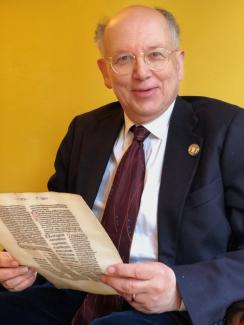Paleography and the Book Lecture 2023, May 3, 2023, David Rubenstein Forum, University A Room
David Ganz explored how influential scripts such as Caroline minuscule and Italian Humanistic served as models for typefaces like Times New Roman.
In the later Middle Ages, Italian humanists rejected the gothic script used to copy manuscripts and adopted littera antiqua, a script used in twelfth-century Italy. First employed in the reign of Charlemagne at the end of the eighth century, this script transformed the appearance of letters on the page. In 1932, The Times newspaper in London changed its typeface. British typographer Stanley Morison created Times New Roman, which The Times adapted, and it rapidly became the most influential typeface in the world.
View the Paleography and the Book Lecture by David Ganz
About David Ganz

David Ganz writes extensively about early Medieval Latin manuscripts. From 1980 to 1997, he taught in the Department of Classics at the University of North Carolina at Chapel Hill, and then Ganz was appointed as Professor of Palaeography in the University of London at King’s College from 1997 to 2010. He has also taught at the École des Chartes in Paris and as Visiting Professor at the Medieval Institute of the University of Notre Dame. Ganz has held research fellowships from the John Simon Guggenheim Foundation, the Institute of Advanced Study in Princeton and the Department of Manuscripts of the Staatsbibliothek Preussische Kulturbesitz in Berlin.
His publications include Corbie in the Carolingian Renaissance (1990) and the introduction to Two Lives of Charlemagne (2008), and chapters in the New Cambridge Medieval History Volume II (2015), the Cambridge History of the Book in Britain (2019), the Cambridge History of Libraries in Britain and Ireland (2006), the New Cambridge History of the Bible, and the Oxford Handbook of Latin Palaeography (2020). In 2011, Ganz gave the E.A. Lowe lectures at the University of Oxford.
He is a Vice President of the Henry Bradshaw Society and was elected a member of the Comité international de paléographie latine in 2000 and a Corresponding Member of the Monumenta Germaniae Historica in 2016.
